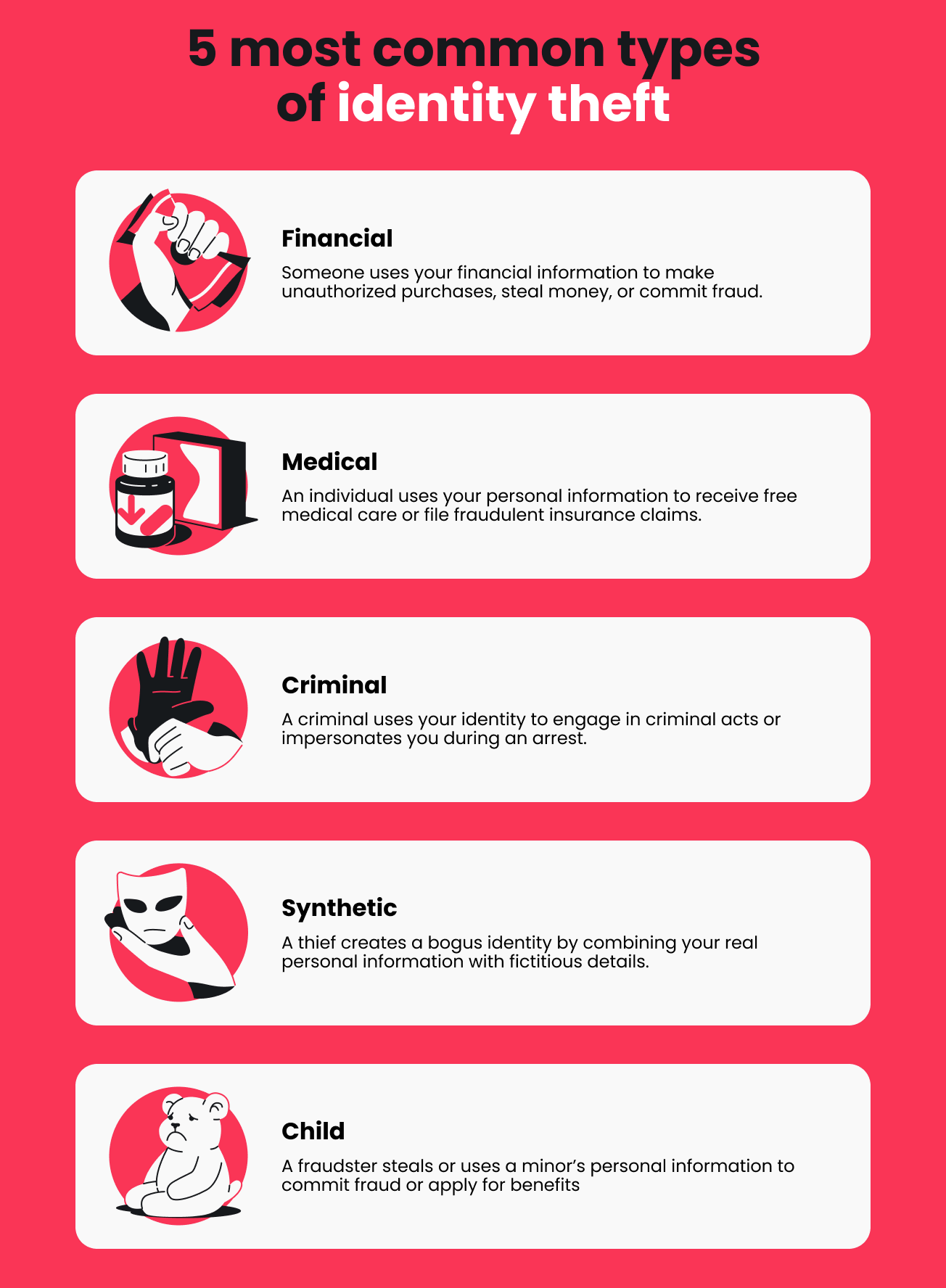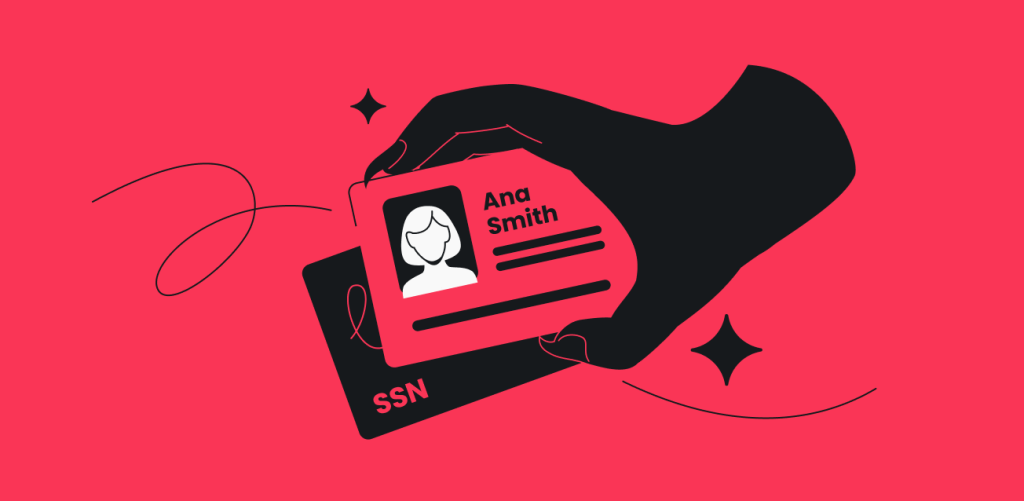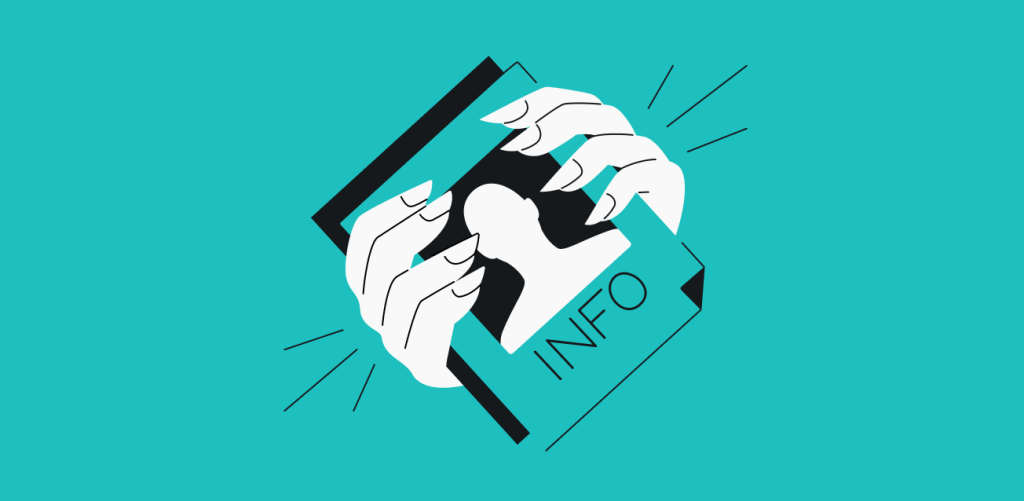From financial to medical and criminal, identity theft is becoming increasingly diverse as fraudsters flex their creative muscles and grow more inventive. With over 211,525 identity theft victims between 2015 and 2022, it’s easier than ever to fall prey.
To stay ahead of these schemes and keep yourself safe, it’s crucial to familiarize yourself with the basics of identity theft. Let’s run through what you need to know — from the different types and warning signs to the steps you can take to protect yourself.
What is identity theft?
Identity theft is the illegal use of someone else’s personal information to commit fraud or other crimes. It typically involves stealing sensitive data such as names, ID (identification) numbers, credit card information, and bank account details.
For instance, hackers might exploit data breaches to access your personal information, using it to take out loans or file for government benefits. Old-school thieves could dumpster dive for confidential documents to score information they can use to commit fraud. Meanwhile, eavesdroppers may intercept sensitive information and hijack accounts if your home Wi-Fi security is unsecured.
If left unchecked, identity theft can cause significant damage. Financial losses, plummeting credit ratings, and difficulties in securing loans or credit cards are just some common consequences. You might also face legal trouble if your identity is used for criminal activities. The stress and hassle from identity theft can be overwhelming, too.
What are the different types of identity theft?

There are many types of identity theft out there, some more prevalent than others. This could be because they’re easier to pull off, less detectable, or more lucrative for the thieves. Let’s take a closer look at the most common types.
Financial identity theft
Financial identity theft is one of the most widespread forms, and it’s usually the first thing that comes to mind when you hear “identity theft”. It involves criminals using your financial information for unauthorized purposes. Some examples include:
- Bank account takeover: stealing your banking credentials to withdraw or transfer funds;
- Credit card fraud: using your credit card details to purchase big-ticket items;
- New account fraud: signing up for new banking, credit, or debit cards in your name;
- Loan fraud: applying for loans and credit lines using your identity;
- Utility fraud: setting up utility accounts in your name and leaving you with unpaid bills;
- Mortgage fraud: refinancing or taking out a second mortgage on your property.
Medical identity theft
In medical identity theft, a thief uses your personal information to access free healthcare services. This could involve:
- Medical treatment fraud: using your identity to get medical treatments, surgeries, or procedures and leaving you to foot the bills;
- Prescription scam: obtaining prescription medications under your name, leading to erroneous medical records;
- Insurance fraud: filing false claims with your health insurance, potentially raising your premiums or causing coverage issues;
- Durable Medical Equipment (DME) fraud: purchasing pricey medical equipment like wheelchairs or oxygen tanks and charging them to your account or insurance.
Criminal identity theft
A thief might impersonate you and provide your personal information during an arrest in criminal identity theft. They may do this to keep their own criminal record clean or prevent the discovery of an outstanding warrant. By giving false info, they stir up confusion and complicate law enforcement efforts.
If your stolen personal information is used this way, you could face arrest for crimes you didn’t commit. Clearing your name and correcting records can be difficult and time-consuming, not to mention costly. While it’s usually possible to resolve these issues, in the worst-case scenario, you might end up taking the fall and being wrongfully imprisoned for the thief’s crimes.
Synthetic identity theft
Synthetic identity theft is when a criminal creates a new, fake identity by combining real and fictitious information. They typically use legitimate personal data, such as your ID number, to “anchor” the synthetic identity and combine it with made-up details like a fake name. This new identity is then used to make purchases, apply for loans, and pull off other fraudulent activities.
While banks and creditors usually take the biggest hit from synthetic identity theft, you could still be affected if your information is involved. Worse, you might not even realize it until problems pop up, as the identity is partly fabricated. The blend of fact and fiction also makes it harder for authorities to track down the crooks.
Child identity theft
Scammers might use a minor’s information to commit fraud in cases of child identity theft. Children are attractive targets due to their squeaky-clean credit histories. Very often, this type of identity theft is carried out by a family member, friend, or someone with access to the child’s personal details.
Child identity theft can be particularly harmful because it often goes undetected for years. If the parents aren’t behind it, they might not think to check their child’s credit report, assuming nothing is happening. As a result, the theft can remain unnoticed until the child applies for student loans, jobs, or credit later in life.
What are the signs of identity theft?
Watch for clues that might indicate you’re a target or an unwitting victim of identity theft to catch it early. Let’s go over some of them.
Unfamiliar charges or withdrawals
One of the most obvious signs of identity theft is seeing unfamiliar charges or withdrawals on your banking accounts. If you spot transactions you don’t recognize, there’s a good chance someone might have accessed your account without permission.
Don’t ignore small transactions either. Criminals often test the waters with small charges to see if the account is active and if you’re vigilant. After successful tests, they might try for larger withdrawals or more expensive buys. They also hope the hassle of reporting will make you less likely to follow up since they’re just pocketing or spending small sums.
Missing bills or statements
If you suddenly stop receiving your bills and statements in the mail, it could be a red flag. This might indicate that someone is stealing or intercepting your sensitive mail, which could lead to identity theft.
Another possibility is that identity thieves have changed your billing address with your creditors, redirecting your mail to another location. This way, you won’t receive statements that could tip you off to suspicious charges, withdrawals, or financial applications, allowing their crimes to continue without detection.
Unexpected credit denials
If you have a strong credit history and rating but find yourself unexpectedly denied credit or a loan, you might be a victim of identity theft. Your credit score may have taken a beating due to these reasons:
- Scammers could have taken out loans in your name and accrued debt;
- Someone might have opened new credit accounts in your name and failed to make payments;
- Thieves might be using your identity to purchase items, resulting in unpaid bills on your credit report;
- There might have been multiple credit inquiries in a short period as thieves used your identity to open new accounts.
Calls from debt collectors about unknown debts
Receiving calls from debt collectors is never pleasant, but it can also be a warning sign of identity theft. If you get calls about unpaid debts for accounts you didn’t open or loans you didn’t take out, it could mean someone is using your personal information to commit fraud.
However, it’s worth noting that debt collections don’t always happen right away. Sometimes, it can take months or even years before collectors chase down outstanding debts. By the time you receive these calls, the damage may have already been done.
What can you do to protect yourself from identity theft?
While there’s no foolproof way to prevent identity theft, you can minimize the risk by exercising caution and using available resources. Here are some steps to protect yourself.
Monitor your accounts
Regularly review your accounts to catch unusual activities early. Look out for unfamiliar purchases, unexpected withdrawals, or unrecognized logins. Don’t brush off even the smallest discrepancies, as they can be a sign of fraud. If you find anything suspicious, notify your bank, service provider, utility company, or the relevant party immediately.
Many institutions and services also offer automatic alerts for transactions and logins, allowing you to receive real-time notifications. By staying vigilant, you can help catch identity theft before it escalates and take swift actions, such as freezing your accounts.
Use strong, unique passwords
Create strong passwords for all your accounts, whether they’re for banking, email, or other services. Strong passwords are complex, with a mix of upper and lowercase letters, numbers, and symbols that make them difficult to crack through guessing or brute force attacks. In contrast, weak passwords like “abc123” or “password” practically hand over your accounts to thieves.
Additionally, use unique passwords for each account. If a bad actor knows the login credentials for one of your accounts, chances are they will try them on your other accounts. This way, even if one account is compromised, the rest remain safe. Also, make it a point to regularly change your passwords to protect against data breaches and leaks.
Enable two-factor authentication
2FA (two-factor authentication) adds another crucial layer of security to protect your online accounts. When enabled, you’ll have to provide a second form of verification to confirm your identity before you can log in. Common 2FA methods include security codes sent to your phone via calls, texts, or push notifications and codes generated by authenticator apps.
Even if thieves manage to steal your passwords, they can’t access your accounts without clearing the second verification step — reducing the risk of identity theft. Additionally, you’ll receive alerts for unauthorized login attempts and can take action to secure your data.
Be cautious with personal information
One of the simplest yet effective methods to protect against identity theft is to be cautious with your personal information. Here are some steps you can take to guard it:
- Be selective about what you share on social media;
- Exercise caution when someone requests personal details like ID number;
- Share sensitive information only with verified parties;
- Make sure a website is secure before keying in personal data;
- Steer clear of suspicious links and fishy websites;
- Avoid accessing sensitive accounts on hotel Wi-Fi or other public networks;
- Consider locking your physical mailbox to prevent tampering.
Shred sensitive documents
Shredding documents might make you feel like a mobster in a noir film, but it’s a smart move to protect against identity theft. Thieves often go through trash for sensitive information like bank account details, bills, and medical records, which they can exploit. Shredding your papers helps remove the risk of exposing this information.
Before shredding, be sure to set aside the documents you need to retain for legal or financial reasons, such as tax returns and recent statements. You might also consider securely storing digital copies of important documents.
Use Alternative ID
Using Surfshark’s Alternative ID adds an extra layer of protection against identity theft by keeping your personal information private. It generates a new email address and identity — allowing you to customize your alternative persona’s name, date of birth, address, gender, and country.
You can use this persona to sign up for new accounts, subscribe to newsletters, and more. This way, your primary email and actual personal details aren’t shared with every website or service you interact with, giving you control over who can access your real information.
Don’t lose your identity — safeguard your personal information now
Knowing how to spot the warning signs that someone is using your identity without permission is critical. Watch for red flags like unfamiliar charges, missing bills, and unexpected calls from debt collectors. Catching these signs early allows you to remedy the issue quickly, minimizing potential damage.
Still, the best defense against identity theft is preventing it from happening in the first place. This means monitoring your accounts, using strong passwords, and being cautious with your personal information. Using Alternative ID can also help keep your personal information secure, reducing the risk of it falling into the wrong hands.
FAQ
What are the three most common types of identity theft?
The three most common types of identity theft are financial identity theft, medical identity theft, and criminal identity theft.
How do I check if my SSN is being used?
To check if your SSN is being used by someone else, review your credit reports for unrecognized accounts, scrutinize your Social Security Statement for unusual earnings, check for suspicious changes to your bank account statements, and vet your tax returns for discrepancies.
How do I know if my ID is being used by someone else?
Your ID might be used by someone else if you notice warning signs like unfamiliar financial transactions, changes to your credit report, or denial of credit or loans. You might also receive suspicious emails or calls or find unusual activity on your online accounts.
What are the three Ds of identity theft?
The three Ds of identity theft are Deter, Detect, and Defend. Deter means being cautious with your personal information to prevent identity theft. Meanwhile, Detect involves routinely monitoring your accounts for suspicious activity. Finally, Defend means quickly taking steps to secure your personal information if you suspect it’s at risk.




